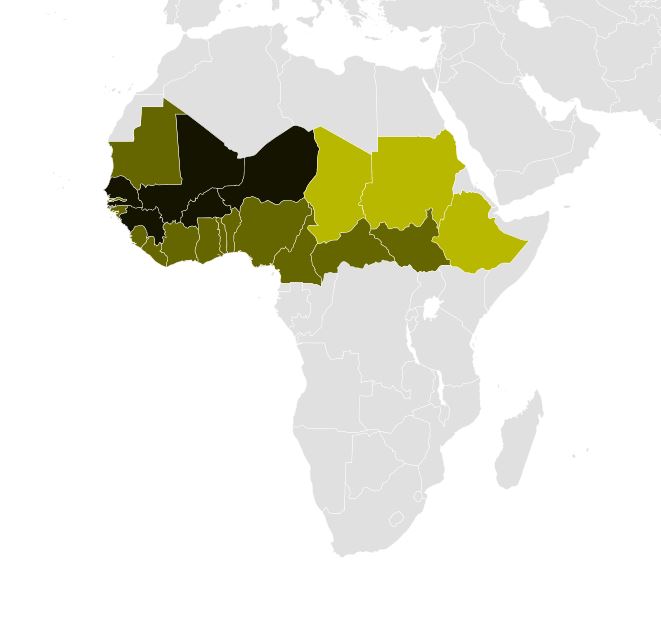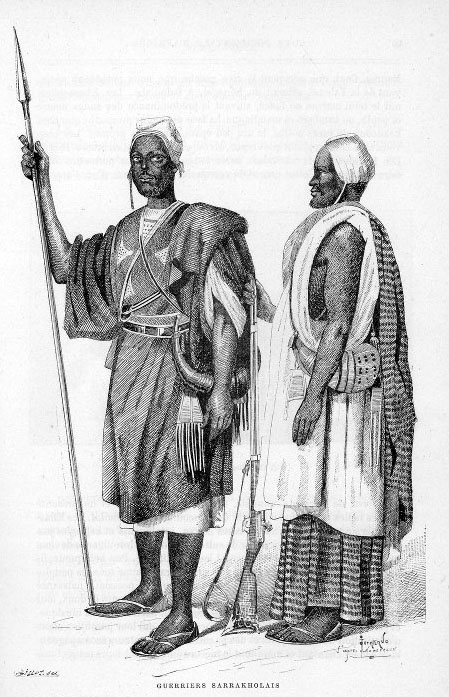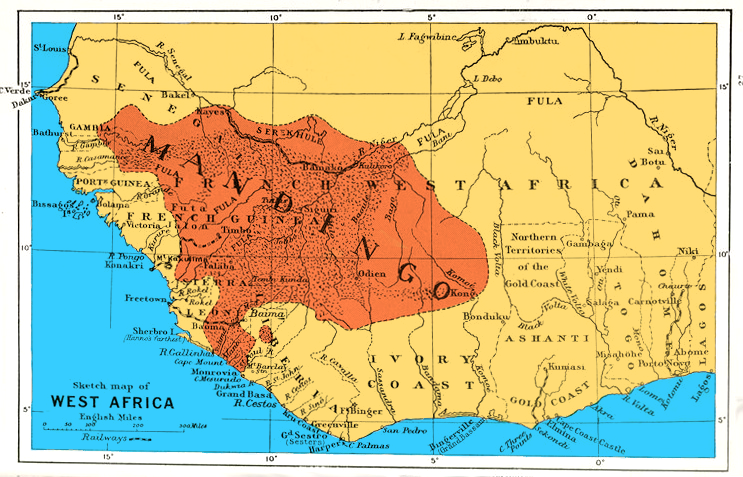|
Soninke-Marabout Wars
The Soninke-Marabout Wars were a series of 19th-century civil wars across southern Senegambia pitting the traditional ruling classes of various states, mostly animist or only nominally Muslim, against Islamic reformers led by the marabout class. French and British forces frequently became involved in these conflicts, providing them an opportunity to extend colonial power into the hinterland. Name In 19th century Senegambia, the term 'Soninke' designated the animist of nominally Muslim traditional warrior ruling class. These groups were mostly Mandinka rather than ethnically Soninke. Other terms for the traditional animist ruling class included '' ceddo'' and '' Nyancho''. Background Two principal factors laid the groundwork for the outbreak of widespread violence in Senegambia in the 19th century. The first was the increasing prominence of Muslims in traditionally non-Islamic states. Since the 17th century an increasingly arid climate had pushed Fula pastoralists further and f ... [...More Info...] [...Related Items...] OR: [Wikipedia] [Google] [Baidu] |
Senegambia
The Senegambia (other names: Senegambia region or Senegambian zone,Barry, Boubacar, ''Senegambia and the Atlantic Slave Trade'', (Editors: David Anderson, Carolyn Brown; trans. Ayi Kwei Armah; contributors: David Anderson, American Council of Learned Societies, Carolyn Brown, University of Michigan. Digital Library Production Service, Christopher Clapham, Michael Gomez, Patrick Manning, David Robinson, Leonardo A. Villalon), Cambridge University Press (1998) p. 5,(Retrieved 15 March 2019) Senegàmbi in Wolof language, Wolof and Pulaar, Senegambi in Serer) is, in the narrow sense, a historical name for a geographical region in West Africa, named after the Senegal River in the north and the Gambia River in the south. However, there are also text sources which state that Senegambia is understood in a broader sense and equated with the term the Western region. This refers to the coastal areas between Senegal and Sierra Leone, where the inland border in the east was not further def ... [...More Info...] [...Related Items...] OR: [Wikipedia] [Google] [Baidu] |
Animist
Animism (from meaning 'breath, spirit, life') is the belief that objects, places, and creatures all possess a distinct spiritual essence. Animism perceives all things—animals, plants, rocks, rivers, weather systems, human handiwork, and in some cases words—as being animated, having agency and free will. Animism is used in anthropology of religion as a term for the belief system of many Indigenous peoples in contrast to the relatively more recent development of organized religions. Animism is a metaphysical belief which focuses on the supernatural universe: specifically, on the concept of the immaterial soul. Although each culture has its own mythologies and rituals, animism is said to describe the most common, foundational thread of indigenous peoples' "spiritual" or "supernatural" perspectives. The animistic perspective is so widely held and inherent to most indigenous peoples that they often do not even have a word in their languages that corresponds to "animism" (or ... [...More Info...] [...Related Items...] OR: [Wikipedia] [Google] [Baidu] |
West Africa
West Africa, also known as Western Africa, is the westernmost region of Africa. The United Nations geoscheme for Africa#Western Africa, United Nations defines Western Africa as the 16 countries of Benin, Burkina Faso, Cape Verde, The Gambia, Ghana, Guinea, Guinea-Bissau, Ivory Coast, Liberia, Mali, Mauritania, Niger, Nigeria, Senegal, Sierra Leone, and Togo, as well as Saint Helena, Ascension and Tristan da Cunha (United Kingdom Overseas Territories, United Kingdom Overseas Territory).Paul R. Masson, Catherine Anne Pattillo, "Monetary union in West Africa (ECOWAS): is it desirable and how could it be achieved?" (Introduction). International Monetary Fund, 2001. The population of West Africa is estimated at around million people as of , and at 381,981,000 as of 2017, of which 189,672,000 were female and 192,309,000 male.United Nations Department of Economic and Social Affairs, Population Division (2017). World Population Prospects: The 2017 Revision, custom data acquired via webs ... [...More Info...] [...Related Items...] OR: [Wikipedia] [Google] [Baidu] |
Fula Jihads
The Fula (or Fulani) jihads () sometimes called the Fulani revolution were a series of jihads that occurred across West Africa during the 18th and 19th centuries, led largely by the Muslim Fula people, Fulani people. The jihads and the jihad states came to an end with Scramble for Africa, European colonization. The earliest Fulbe polity was established in Bundu (state), Bundu in 1690. The first armed uprising took place in Futa Jallon in 1725, when Fula pastoralists, assisted by Muslim traders, rose against the indigenous chiefdoms. By 1750, the Fula had established the Imamate of Futa Jallon and placed the region under sharia law. Their success inspired the Toucouleur people, Toucouleurs on the banks of the lower Senegal river, Senegal to establish their own state, the Imamate of Futa Toro, through a series of wars between 1769 and 1776. In the early 19th century, the jihad movement spread eastward to the Hausa states. The revolutionary Usman dan Fodio, through Fulani War, a ser ... [...More Info...] [...Related Items...] OR: [Wikipedia] [Google] [Baidu] |
Futa Toro
Futa Toro (Wolof language, Wolof and , , ; ), often simply the Futa, is a semidesert region around the middle run of the Senegal River. This region, along the border of Senegal and Mauritania, is historically significant as the center of several Fula people, Fulani states, and a source of jihad armies and migrants to the Fouta Djallon. The word Futa is a general name the Fulbe gave to any area they lived in, while Toro was the actual identity of the region for its inhabitants, likely derived from the ancient kingdom of Takrur. The people of the area mostly speak Pulaar, a dialect of the Fula language, Fula language that spans West Africa from Senegal to Cameroon. They identified themselves by the language giving rise to the name Haalpulaar'en meaning those who speak Pulaar. The Haalpulaar'en are also known as Toucouleur people, Toucouleurs (var. ''Tukolor''), a name also derived from of Takrur. Geography The Futa Toro stretches for about 400 kilometers, but only a narrow band of ... [...More Info...] [...Related Items...] OR: [Wikipedia] [Google] [Baidu] |
Torodbe
The Torodbe; singular Torodo (also called Turudiyya, Banu Toro, Takrur, Toronkawa) were Muslim Toucouleur people, Toucouleur clerics and theocratic monarchs who preached and reigned in Futa Toro, a region located in the north of present-day Senegal, and other Fula communities in West Africa from at least the seventeenth to the early twentieth century. Drawn from all ethnicites and levels of society, the Torodbe aimed to 'purify' the Islam practiced in West Africa and establish Islamic states run with Islamic law. Origins The Torodbe originated in Futa Toro, a strip of agricultural land along the Senegal River and at the time the state of Takrur, from as early as the 9th to as late as 13th century, later spreading throughout the Fulbe territories. They may well have been a distinct group by the fifteenth century, when the Denianke Dynasty, Denianke conquered Takrur, creating the Empire of Great Fulo. In 1644 the Zawaya Berbers, Berber reformer Nasr ad-Din (Lamtuna), Nasr ad-Din l ... [...More Info...] [...Related Items...] OR: [Wikipedia] [Google] [Baidu] |
Fula People
The Fula, Fulani, or Fulɓe people are an ethnic group in Sahara, Sahel and West Africa, widely dispersed across the region. Inhabiting many countries, they live mainly in West Africa and northern parts of Central Africa, South Sudan, Darfur, and regions near the Red Sea coast in Sudan. The approximate number of Fula people is unknown, due to clashing definitions regarding Fula ethnicity. Various estimates put the figure between 25 and 40 million people worldwide. A significant proportion of the Fula – a third, or an estimated 7 to 10 million – are pastoralism, pastoralists, and their ethnic group has the largest nomadic pastoral community in the world., Quote: The Fulani form the largest pastoral nomadic group in the world. The Bororo'en are noted for the size of their cattle herds. In addition to fully nomadic groups, however, there are also semisedentary Fulani – Fulbe Laddi – who also farm, although they argue that they do so out of necessity, not choice. The major ... [...More Info...] [...Related Items...] OR: [Wikipedia] [Google] [Baidu] |
Nyancho
The Nyancho (also spelled ''Nyantio'', '' Ñaanco'', ''Nyanthio'' or ''Nyanco'') were a royal maternal dynasty that ruled the West African empire of Kaabu. Origins The Nyancho's legendary origins begin with a Mandinka woman named Balaba, or in some versions Tenemba. She fled the Manding region to Mampatim, at the time the center of a Bainuk kingdom, and took shelter in a cave. Pregnant at the time of her arrival, the local population took her for a djinn or sorceress as there was no man living with her. She gave birth to three daughters who were then married to the three sons of Tiramakhan Traore, who had led a powerful force to incorporate the area into the Mali Empire. The Nyancho were the maternal descendants of these three couples. They could therefore claim legitimacy through conquest, the Mandinka patrilineal inheritance system, and local Bainuk matrilineal traditions. The term 'Nyancho' is derived from the Mandinka phrase ''I nyon ten'', meaning 'you have no equal. Rule ... [...More Info...] [...Related Items...] OR: [Wikipedia] [Google] [Baidu] |
Ceddo
The Ceddo, also spelled Cedo, Tieddo, or Tyeddo, were a class of warrior-slaves in pre-colonial Senegambian societies, particularly Jolof, Cayor, Baol and Waalo. Up until the mid 19th century, they were a powerful political and social group closely aligned with the traditional monarchs of the region against the rise of Islam and colonialism. In modern-day Senegal the word retains negative connotations, and can describe the societies in which the ceddo operated or the followers of traditional African religions generally. Etymology 'Ceddo' is a Fula word for either the Wolof people or the Mandinka, depending on the dialect. It is unknown how it came to be applied to animists generally. History and Role in Society The late 17th and 18th centuries saw repeated rebellions by marabouts attempting to overthrow the partially Islamized kingdoms of Senegambia and replace them with Islamic theocracies. This period created a sharp divide in the ruling classes between the Muslims on one si ... [...More Info...] [...Related Items...] OR: [Wikipedia] [Google] [Baidu] |
Soninke People
The Soninke (Sarakolleh) people are a West African Mande languages, Mande-speaking ethnic group found in Mali, southern Mauritania, eastern Senegal, The Gambia, and Guinea (especially Fouta Djallon). They speak the Soninke language, also called the Serakhulle or Azer language, which is one of the Mande languages. Soninke people were the founders of the ancient Ghana Empire, empire of Ghana or Wagadou c. 200–1240 CE, Subgroups of Soninke include the Jakhanke, Maraka and Soninke Wangara, Wangara. When the Ghana empire was destroyed, the resulting diaspora brought Soninkes to Mali, Mauritania, Senegal, Gambia, Burkina Faso, Côte d'Ivoire, Guinée-Conakry, modern-day Republic of Ghana, Kano in Nigeria, and Guinea-Bissau where some of this trading diaspora was called Wangara, leading to the saying “when Americans landed on the moon, a Soninke was already there” in Senegal, with other versions across West Africa. Predominantly Muslims, the Soninke were one of the early ethnic gr ... [...More Info...] [...Related Items...] OR: [Wikipedia] [Google] [Baidu] |
Mandinka People
The Mandinka or Malinke are a West African ethnic group primarily found in southern Mali, The Gambia, southern Senegal and eastern Guinea. Numbering about 11 million, they are the largest subgroup of the Mandé peoples and one of the List of ethnic groups of Africa, largest ethnolinguistic groups in Africa. They speak the Manding languages in the Mande language family, which are a ''lingua franca'' in much of West Africa. They are predominantly Subsistence agriculture, subsistence farmers and live in rural villages. Their largest urban center is Bamako, the capital of Mali. The Mandinka are the descendants of the Mali Empire, which rose to power in the 13th century under the rule of king Sundiata Keita, who founded an empire that would go on to span a large part of West Africa. They migrated west from the Niger River in search of better agricultural lands and more opportunities for conquest. Nowadays, the Mandinka inhabit the West Sudanian savanna region extending from The Gambia ... [...More Info...] [...Related Items...] OR: [Wikipedia] [Google] [Baidu] |
British Empire
The British Empire comprised the dominions, Crown colony, colonies, protectorates, League of Nations mandate, mandates, and other Dependent territory, territories ruled or administered by the United Kingdom and its predecessor states. It began with the English overseas possessions, overseas possessions and trading posts established by Kingdom of England, England in the late 16th and early 17th centuries, and colonisation attempts by Kingdom of Scotland, Scotland during the 17th century. At its height in the 19th and early 20th centuries, it became the List of largest empires, largest empire in history and, for a century, was the foremost global power. By 1913, the British Empire held sway over 412 million people, of the world population at the time, and by 1920, it covered , of the Earth's total land area. As a result, Westminster system, its constitutional, Common law, legal, English language, linguistic, and Culture of the United Kingdom, cultural legacy is widespread. ... [...More Info...] [...Related Items...] OR: [Wikipedia] [Google] [Baidu] |








